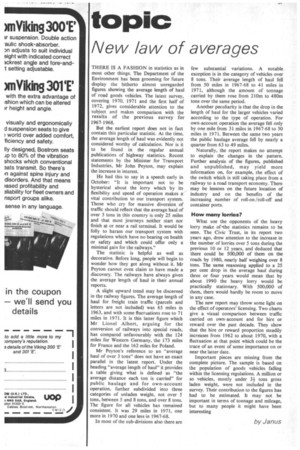New law of averages
Page 39

If you've noticed an error in this article please click here to report it so we can fix it.
THERE IS A FASHION in statistics as in most other things. The Department of the Environment has been grooming for future display the hitherto almost unregarded figures showing the average length of haul of road goods vehicles. The latest survey, covering 1970, 1971 and the first half of 1972, gives considerable attention to the subject and makes comparison with the results of the previous survey for 1967-1968.
But the earliest report does not in fact contain this particular statistic. At the time, the average length of haul was evidently not considered worthy of calculation. Nor is it to be found in the regular annual publications of highway statistics. Recent statements by the Minister for Transport Industries, Mr John Peyton, may explain the increase in interest.
He had this to say in a speech early in October: "It is important not to be hysterical about the lorry which by its flexibility and speed of operation makes a vital contribution to our transport system. Those who cry for massive diversion of traffic should reflect that the average haul of over 3 tons in this country is only 25 miles and that most journeys neither start nor finish at or near a rail terminal. It would be folly to harass our transport system with regulations which have no bearing on health or safety and which could offer only a minimal gain for the railways."
The statistic is helpful as well as decorative. Before long, people will begin to wonder how they got along without it. Mr Peyton cannot even claim to have made a discovery. The railways have always given the average length of haul in their annual reports.
A slight upward trend may be discerned in the railway figures. The average length of haul for freight train traffic (parcels and letters are not included) was 65 miles in 1963, and with some fluctuations rose to 71 miles in 1971. It is this latter figure which Mr Lionel Albert, arguing for the conversion of railways into special roads, has compared unfavourably with the 124 miles for Western Germany, the 173 miles for France and the 162 miles for Poland.
Mr Peyton's reference to an "average haul of over 3 tons" does not have an exact parallel in the latest report. Under the heading "average length of haul" it provides a table giving what is defined as "the average distance each ton is carried" for public haulage and for own-account operation, further subdivided into three categories of unladen weight, not over 5 tons, between 5 and 8 tons, and over 8 tons. The figure for all vehicles has remained consistent. It was 29 miles in 1971, one more in 1970 and one less in 1967-68.
In most of the sub-divisions also there are few substantial variations. A notable exception is in the category of vehicles over 8 tons. Their average length of haul fell from 50 miles in 1967-68 to 41 miles in 1971, although the amount of tonnage carried by them rose from 210m to 480m tons over the same period.
Another peculiarity is that the drop in the length of haul for the larger vehicles varied according to the type of operation. For own-account operation the average fell only by one mile from 31 miles in 1967-68 to 30 miles in 1971. Between the same two years the public haulage average fell by nearly a quarter from 63 to 49 miles.
Naturally, the report makes no attempt to explain the changes in the pattern. Further analysis of the figures, published and unpublished, may yield more information on, for example, the effect of the switch which is still taking place from a railway to a road transport economy. There may be lessons on the future location of industry and on the benefits of the increasing number of roll-on /roll-off and container ports.
How many lorries?
What use the opponents of the heavy lorry make of the statistics remains to be seen. The Civic Trust, in its report two years ago, drew attention to the increase in the number of lorries over 5 tons during the previous 10 or 12 years, and deduced that there could be 500,000 of them on the roads by 1980, nearly half weighing over 8 tons. The same reasoning applied to a 25 per cent drop in the average haul during three or four years would mean that by about 1990 the heavy lorry would be practically stationary. With 500,000 of them, there would hardly be room to move in any case.
The new report may throw some light on the effect of operators' licensing. Two charts give a visual comparison between traffic carried on own-account and for hire or reward over the past decade. They show that the hire or reward proportion steadily increases from 1962 to about 1970, with a fluctuation at that point which could be the trace of an event of some importance on or near the latter date.
Important pieces are missing from the complete picture. The sample is based on the population of goods vehicles falling within the licensing regulations. A million or so vehicles, mostly under 3+ tons gross laden weight, were not included in the survey. Their contribution to the figures has had to be estimated. It may not be important in terms of tonnage and mileage, but to many people it might have been interesting
by Janus








































































































